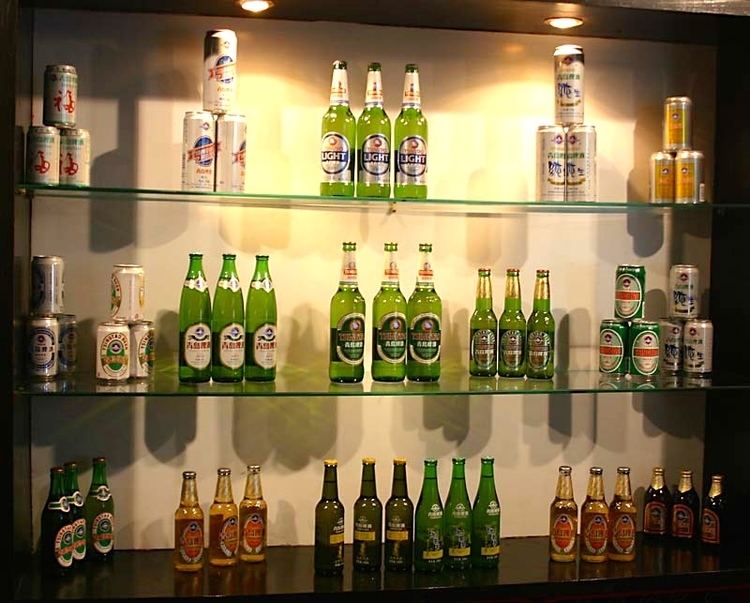 | ||
Beer in China (simplified Chinese: 中国啤酒; traditional Chinese: 中國啤酒; pinyin: Zhōngguó píjiǔ) has become increasingly popular in the last century due to the popularity of Zhujiang Beer and China Pabst Blue Ribbon. Chinese beer has also seen a rise in popularity internationally in the last few decades. While most Chinese beers are pale lagers, other styles are occasionally found, such as Tsingtao Dark Beer.
Contents
History
Production and consumption of beer in China has occurred for around nine thousand years, with recent archaeological findings showing that Chinese villagers were brewing beer-type alcoholic drinks as far back as 7000 BC on small and individual scales. Made with rice, honey, and grape and hawthorn fruits, this early beer seems to have been produced similarly to that of ancient Egypt and Mesopotamia. Ancient Chinese beer was important in ancestral worship, funeral and other rituals of Xia, Shang and Zhou dynasties, and the beer was called as Lao Li (醪醴 in oracle bone script). However, after the Han Dynasty, Chinese beer faded from prominence in favor of huangjiu, which remained the case for the next two millennia. Modern beer brewing was not introduced into China until the end of 19th century, when Russians established a brewery in Harbin, with another three following (also in Harbin), set up by Germans, Czechoslovaks and Russians respectively. Japanese also established in 1934 in Mukden Manchurian Beer, which later became Shenyang Snow Beer and the origin of Snow Beer when it was absorbed in 1994 by China Resources Enterprises.
Emergence of Craft Beer in China
The emergence of craft beer in China started in the large metro areas including Beijing, Shanghai and Guangzhou. Once primarily of interest to expat drinkers, local consumer interest in premium brands and local and imported craft beers is currently on the rise. However, Chinese government regulations have been cited as an obstacle facing new breweries or those wishing to expand bottling distribution.
Brewing ingredients
Chinese beers often contain rice, sorghum and sometimes rye in addition to barley. Interestingly, some beer is produced that uses bitter melon instead of hops as the bittering agent.
Chinese media reported in 2001 that as many as 95% of all Chinese beers contained formaldehyde, to prevent sedimentation in bottles and cans while in storage. This practice has now been made illegal.
Economy
Snow Beer, produced by CR Snow is the best selling beer in China, holding 21.7% market share, having recently overtaken Tsingtao Beer, produced by Tsingtao Brewery, which is the brand most widely exported to other countries. Tsingtao Beer is brewed in the city of Qingdao (formerly spelled Tsingtao in English) which was a German base in the time of unequal treaties and late-colonial western influence in China. The Germans needed beer for their sailors, soldiers and traders, and production continued after they lost the city to the Japanese in World War I.
Apart from Tsingtao, other major Chinese brewing groups include China Pabst Blue Ribbon, Yanjing, Sie-Tang Lio and Zhujiang Beer. Many major international brewers now have interests in, or joint ventures with, Chinese breweries, and popular international brands such as Carlsberg are now produced in China. This gives them access to the Chinese market, while providing capital and expertise to help upgrade local brewing standards, albeit at the cost of variety.
Brewpubs are gaining popularity in China, primarily in major cities which have a resident western community, though there are a few exceptions in more remote locations like Bad Monkey Brewery in Dali Old Town, Yunnan. The oldest craft brewery in Shanghai is Henry's (which is now closed), followed by The Bund Brewery. Shanghai Brewery, Boxing Cat Brewery, The BREW and Dr. Beer are some of the more prominent craft breweries in Shanghai. In Beijing, several craft breweries such as Great Leap Brewing, Jing-A Brewing, Panda Brew Pub, and Slow Boat Brewery have become staples in the local nightlife scene. Another popular brewpub is Kaiwei Beer House, a chain based in Wuhan. Craft beer festivals have been popularized since the early 2010s in Beijing and Shanghai. Two popular beer festivals in Shanghai, Shanghai International Beer Festival and Shanghai Beer Week, were both started in 2012.
Since 2011, a few specialty beer delivery services were launched in Shanghai such as Cheers In and Dean's Bottle Shop.
In 2015 market share of imported beer reached 1.14% and volume increased by 58.9% to 538.5 million litres.
List of major Chinese beers
Note: This is a partial list of China's major breweries. The vast majority of China's breweries serve only their local vicinity.
Hong Kong beers
Hong Kong has a large brewery owned by San Miguel Corporation of the Philippines, as well as a microbrewery producing several beers for the local market.
